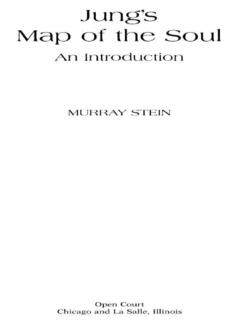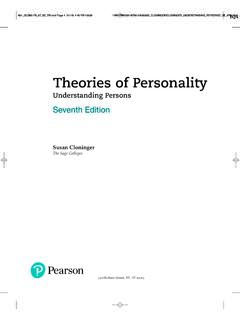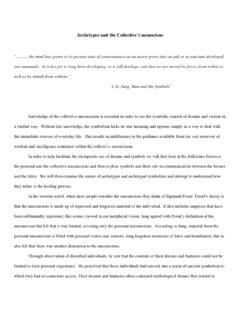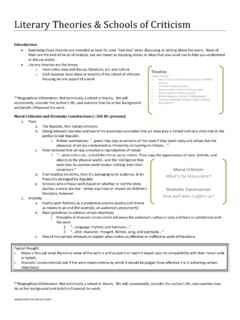Transcription of THEORIES of PERSONALITY - I
1 THEORIES of PERSONALITY - I. Anjelika im ek Analytical psychology Carl Jung Analytical psychology Occult phenomena can and do influence the lives of everyone. Each of us is motivated not only by repressed experiences but also by certain emotionally toned experiences inherited from our ancestors. Inherited images make up what Jung called the collective unconscious. The collective unconscious includes those elements that we have never experienced individually but which have come down to us from our ancestors. Some elements of the collective unconscious become highly developed and are called archetypes. The most inclusive archetype is the notion of self-realization, which can be achieved only by attaining a balance between various opposing forces of PERSONALITY . Thus, Jung's theory is a compendium of opposites.
2 People are both introverted and extraverted; rational and irrational; male and female;. conscious and unconscious; and pushed by past events while being pulled by future expectations. BIOGRAPHY OF CARL GUSTAV JUNG. Carl Gustav Jung Born: July 26, 1875, in Kesswil, a town on Lake Constance in Switzerland. Jung's father, Johann Paul Jung, was a minister in the Swiss Reformed Church, and his mother, Emilie Preiswerk Jung, was the daughter of a theologian. Jung's mother's family had a tradition of spiritualism and mysticism, and his maternal grandfather, Samuel Preiswerk, was a believer in the occult and often talked to the dead. Jung's parents had three children, a son born before Carl but who lived only 3 days and a daughter 9 years younger than Carl. Thus, Jung's early life was that of an only child.
3 Carl Gustav Jung An emotional and sensitive child, Jung identified more with this second side of his mother (unstable, mystical, clairvoyant, archaic, and ruthless), which he called her No. 2 or night PERSONALITY (Alexander, 1990). At age 3 years, Jung was separated from his mother, who had to be hospitalized for several months, and this separation deeply troubled young Carl. For a long time after, he felt distrustful whenever the word love . was mentioned. Years later he still associated woman with unreliability, whereas the word father meant reliable but powerless (Jung, 1961). Carl Gustav Jung During his school years, Jung gradually became aware of two separate aspects of his self, and he called these his No. 1 and No. 2 personalities. In Memories, Dreams, Reflections, Jung (1961) wrote of his No.
4 2. PERSONALITY : I experienced him and his influence in a curiously unreflective manner; when he was present, No. 1 PERSONALITY paled to the point of nonexistence, and when the ego that became increasingly identical with No. 1 PERSONALITY dominated the scene, the old man, if remembered at all, seemed a remote and unreal dream. Carl Gustav Jung In Jung's own theory of attitudes, his No. 1 PERSONALITY was extraverted and in tune to the objective world, whereas his No. 2 PERSONALITY was introverted and directed inward toward his subjective world. After completing his medical degree from Basel University in 1900, Jung became a psychiatric assistant to Eugene Bleuler at Burgh ltzli Mental Hospital in Z rich, possibly the most prestigious psychiatric teaching hospital in the world at that time.
5 Married Emma Rauschenbach, a young sophisticated woman from a wealthy Swiss family Carl Gustav Jung Freud had warm personal feelings for Jung and regarded him as a man of great intellect. These qualifications prompted Freud to select Jung as the first president of the International Psychoanalytic Association. In 1909, G. Stanley Hall, the president of Clark University and one of the first psychologists in the United States, invited Jung and Freud to deliver a series of lectures at Clark University in Worcester, Massachusetts Jung also asserted that, during the trip to America, Freud was unable to interpret Jung's dreams, especially one that seemed to contain rich material from Jung's collective unconscious. Carl Gustav Jung In this dream, Jung and his family were living on the second floor of his house when he decided to explore hitherto unknown levels of his house.
6 At the bottom level of his dwelling, he came upon a cave where he found two human skulls, very old and half disintegrated . Jung associate the skulls to some wish. Whom did Jung wish dead? My wife and my sister-in-law after all, I had to name someone whose death was worth the wishing! . I was newly married at the time and knew perfectly well that there was nothing within myself which pointed to such wishes . (Jung, 1961). Carl Gustav Jung At that time, Jung was not newly married but had been married for nearly 7 years, and for the previous 5 of those years he was deeply involved in an intimate relationship with a former patient named Sabina Spielrein. Jung needed more than one woman to satisfy the two aspects of his PERSONALITY . However, the two women who shared Jung's life for nearly 40.
7 Years were his wife Emma and another former patient named Antonia (Toni) Wolff (Bair, 2003). Emma Jung seemed to have related better to Jung's No. 1. PERSONALITY while Toni Wolff was more in touch with his No. 2. PERSONALITY . Carl Gustav Jung In any event, little doubt exists that Jung needed women other than his wife. In a letter to Freud dated January 30, 1910, Jung wrote: The prerequisite for a good marriage, it seems to me, is the license to be unfaithful (McGuire, 1974, p. 289). In 1907, Jung wrote to Freud of his boundless admiration for him and confessed that his veneration has something of the character of a religious' crush and that it had an undeniable erotic undertone (McGuire, 1974, p. 95). Jung continued his confession, saying: This abominable feeling comes from the fact that as a boy I was the victim of a sexual assault by a man I once worshipped.
8 Jung's rejection of Freud's sexual THEORIES may have stemmed from his ambivalent sexual feelings toward Freud. Carl Gustav Jung From December of 1913 until 1917, he underwent the most profound and dangerous experience of his life a trip through the underground of his own unconscious psyche. Jung's period of creative illness was similar to Freud's self- analysis. Both men began their search for self while in their late 30s or early 40s: Freud, as a reaction to the death of his father; Jung, as a result of his split with his spiritual father, Freud. Carl Gustav Jung A Christian, but did not attend church. Hobbies included wood carving, stone cutting, and sailing his boat on Lake Constance. In 1944, he became professor of medical psychology at the University of Basel, but poor health forced him to resign his position the following year.
9 After his wife died in 1955, he was mostly alone, the wise old man of K snacht.. He died June 6, 1961, in Z rich, a few weeks short of his 86th birthday. At the time of his death, Jung's reputation was worldwide, extending beyond psychology to include philosophy, religion, and popular culture (Brome, 1978). LEVELS OF THE PSYCHE. Conscious Conscious images are those that are sensed by the ego, whereas unconscious elements have no relationship with the ego. Ego as the center of consciousness, but not the core of PERSONALITY . Self, the center of PERSONALITY that is largely unconscious In a psychologically healthy person, the ego takes a secondary position to the unconscious self (Jung, 1951/1959a). Healthy individuals are in contact with their conscious world, but they also allow themselves to experience their unconscious self and thus to achieve individuation.
10 Personal unconscious Embraces all repressed, forgotten, or subliminally perceived experiences of one particular individual. Formed by our individual experiences and is therefore unique to each of us. Contents of the personal unconscious are called complexes. A complex is an emotionally toned conglomeration of associated ideas. For example, a person's experiences with Mother may become grouped around an emotional core so that the person's mother, or even the word mother, sparks an emotional response that blocks the smooth flow of thought. Collective unconscious Has roots in the ancestral past of the entire species Inherited and pass from one generation to the next as psychic potential. Distant ancestors' experiences with universal concepts such as God, mother, water, earth, and so forth have been transmitted through the generations so that people in every clime and time have been influenced by their primitive ancestors' primordial experiences (Jung, 1937/1959).







